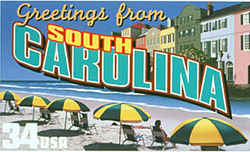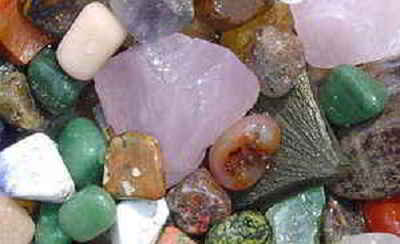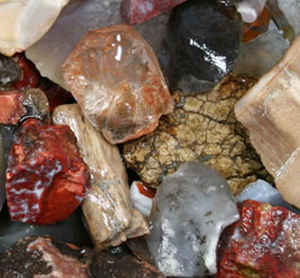
South Carolina Symbols
South Carolina State Stone
Blue Granite

Adopted on June 24, 1969.
Blue Granite, a light-blue or gray-colored igneous stone, became the official stone of South Carolina when House Bill No. 1808 (H1808) was signed by Governor Robert McNair on June 24, 1969. H1808 also named the amethyst the official gem stone of South Carolina. The Act stated that "the blue granite stone of this State has been widely used to beautify all areas of South Carolina.
Among the most popular, the hardest, and the oldest of geosymbols, granite is an official symbol of New Hampshire, Massachusetts, North Carolina, South Carolina, Vermont, and Wisconsin.
South Carolina State Stone: Blue Granite

The South Carolina State Stone, Blue Granite, is unique to the Midlands and the Piedmont region of South Carolina, where granite can be found in abundance. When the bill designating this symbol was passed in 1969, legislators declared that it had been used "to beautify all areas of South Carolina" and was thus the most appropriate choice. It was even used in the 1908 construction of the South Carolina Statehouse
Often referred to as Winnsboro Blue Granite or simply Winnsboro Blue, this light-blue or gray-colored stone was quarried in Fairfield County between 1883 and 1946. Granite is an igneous stone, meaning that it was formed when magma (or molten rock) was trapped beneath the surface of the earth. There, it intermingled with other stones and particles (in this case, flecks of mica and quartz), cooling very slowly and then crystallizing.
AGranite has many uses beyond that of kitchen tile and counter tops. It can be cut into block and carved into monuments, or set as curbstone and
building facing. Granite blocks with irregularities can be used in the construction of coastal jetties, which help prevent beach erosion.
A 1909 document from the Board of Public Works of Charleston reported that more than 28,000 linear feet (5.3 miles!) of granite curb were placed along
its streets that year. Another 12,000 square yards of granite block were used to pave Charleston streets in the traditional cobbled style.

South Carolina has historically been one of the nation's
top producers of granite. Granite weighs approximately 180 pounds per cubic foot, so transporting it by rail was the most efficient means. The Rockton
and Rion Railway, based in Fairfield County, allowed large quantities of stone to be transported all over the country, where it was then used in building
construction.
Buildings from Columbia all the way to Philadelphia were built from the stone quarried at the Winnsboro mine, pictured below. Local granite companies
and the Rockton and Rion Railway made it possible for this small farming community to jump headfirst into the Industrial Revolution.
A 1893 publication by Clinton-native Thornwell Jacobs describes South Carolina's State Stone as "the silk of the trade." A prized stone, it was used in the 1912 construction of Songbird Manor, the first home in Fairfield County to boast an indoor bathroom. Prior to the official mine's operation, this beautiful stone was used in the 1803 construction of the Little River Church, located only a mile from the modern quarry. The foundation, steps, and even the fenceposts were all carved from blocks of Blue Granite.
The Rock - BLUE GRANITE
Granite is an igneous rock, which means that at one time during it's development, it was melted like volcanic lava.
Unlike molten lava however, it was unable to escape to the surface. It remained trapped, below ground where it slowly cooled and crystallized, resulting in a very uniform speckled stone that can range in colors from black and grey, to pink and blue, brown and red.
Granite is a light-colored igneous rock with grains large enough to be visible with the unaided eye. It forms from the slow crystallization of magma below Earth's surface. Granite is composed mainly of quartz and feldspar with minor amounts of mica, amphiboles and other minerals. This mineral composition usually gives granite a red, pink, gray or white color with dark mineral grains visible throughout the rock.
- Igneous Rock Type: Intrusive
- Related to: Rhyolite, pegmatite, syenite
- Chemistry: Acidic
- Color: White, pink, orange, gray, black
- Texture: Phaneritic (easy to see crystals)
- Origins: Orogenic Plutons
- Common Minerals: Quartz, feldspars, hornblende and micas
- Accessory Minerals: Tourmaline, phosphates, rare earth oxides, beryl, topaz, zircons, augite, sphene and apatite
- Uses: Building material, decorative counter tops, tiles, tombstones, roads, jewelry, curling stones, marbles
South Carolina House Bill No. 1808 (H1808)
(R494, H1808, A345)
AN ACT
TO DESIGNATE THE AMETHYST AS THE OFFICIAL STATE GEM STONE AND BLUE GRANITE AS THE OFFICIAL STATE STONE.
Whereas, South Carolina is one of three states where the gem stone amethyst of good quality is found in the United States; and
Whereas, the curator of mineralogy for the Smithsonian Institute has graded one of the largest early specimens from this State as the finest seen in
the country; and
Whereas, such stone now holds first place in the amethyst section in the Institute; and
Whereas, the amethyst is the most prized type of quartz for its wide use and various shades and hue from deep orchid color; and
Whereas, the blue granite stone of this State has been widely used to beautify all areas of South Carolina; and
Whereas, South Carolina has a state flag, a state flag, a state song, a state bird, a state flower, a state tree; and
Whereas, in preparing for the Three-hundredth Anniversary of the founding of this State, it is only fitting that a State gem stone and a state stone
be officially adopted. Now, therefore,
Be it enacted by the General Assembly of the State of South Carolina:
SECTION 1. Official gem of State.--The amethyst is the official gem stone of the State.
SECTION 2. Official stone of State.--Blue granite is the official stone of the State.
SECTION 3. Time effective.--This act shall take effect upon approval by the Governor.
Approved the 24th day of June, 1969
----------
South Carolina Law
The law designating the blue granite as the official South Carolina state stone is found in the South Carolina Code of Laws, Title 1, Chapter 1, Article 9, Section 1-1-620.
Title 1 - Administration of the Government
CHAPTER 1. GENERAL PROVISIONS
ARTICLE 9. STATE EMBLEMS, PLEDGE TO STATE FLAG, OFFICIAL OBSERVANCES
SECTION 1-1-620.
SECTION 1-1-620. Official State stone.
Blue granite is the official stone of the State.
Minerals, & Gems

Gemstone, Minerals, Rocks






